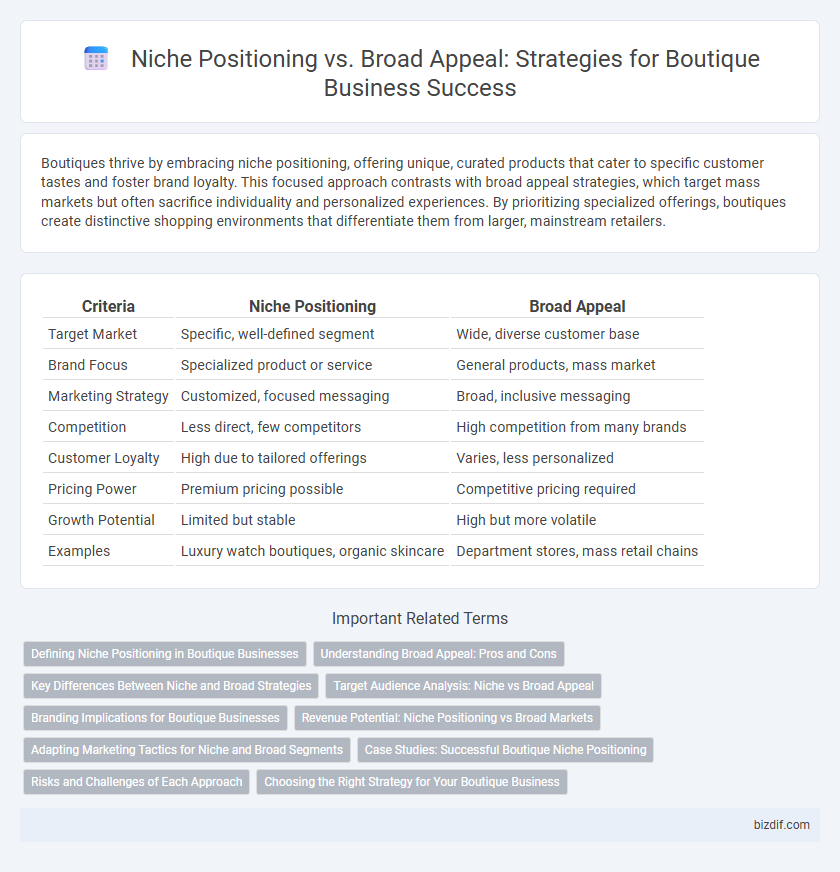Boutiques thrive by embracing niche positioning, offering unique, curated products that cater to specific customer tastes and foster brand loyalty. This focused approach contrasts with broad appeal strategies, which target mass markets but often sacrifice individuality and personalized experiences. By prioritizing specialized offerings, boutiques create distinctive shopping environments that differentiate them from larger, mainstream retailers.
Table of Comparison
| Criteria | Niche Positioning | Broad Appeal |
|---|---|---|
| Target Market | Specific, well-defined segment | Wide, diverse customer base |
| Brand Focus | Specialized product or service | General products, mass market |
| Marketing Strategy | Customized, focused messaging | Broad, inclusive messaging |
| Competition | Less direct, few competitors | High competition from many brands |
| Customer Loyalty | High due to tailored offerings | Varies, less personalized |
| Pricing Power | Premium pricing possible | Competitive pricing required |
| Growth Potential | Limited but stable | High but more volatile |
| Examples | Luxury watch boutiques, organic skincare | Department stores, mass retail chains |
Defining Niche Positioning in Boutique Businesses
Niche positioning in boutique businesses centers on targeting a specific segment of the market with tailored products or services that meet unique customer needs. This approach leverages specialized expertise and distinct brand identity to create strong customer loyalty and differentiate from competitors. By focusing on a well-defined audience, boutique businesses can command premium pricing and foster deeper engagement.
Understanding Broad Appeal: Pros and Cons
Broad appeal targets a wide audience, maximizing market reach and potential sales volume by offering versatile products or services. This strategy often leads to increased brand recognition and economies of scale but risks diluting brand identity and failing to meet specific customer needs. Businesses must balance broad appeal's growth opportunities against the challenges of standing out in a crowded market.
Key Differences Between Niche and Broad Strategies
Niche positioning targets a specific, well-defined audience with tailored products and marketing, ensuring deeper customer loyalty and higher conversion rates. Broad appeal strategies aim to attract a wide market by offering generalized products and messaging, which can increase brand awareness but often face intense competition. The key difference lies in niche brands prioritizing specialization and unique value propositions, while broad strategies emphasize mass reach and scalability.
Target Audience Analysis: Niche vs Broad Appeal
A boutique's success hinges on precise target audience analysis, balancing niche positioning against broad appeal strategies. Focusing on niche markets allows for tailored products that meet specific customer needs, fostering loyalty and reducing competition. Broad appeal targets larger demographics but requires diverse offerings and intensive marketing to maintain relevance across varied consumer segments.
Branding Implications for Boutique Businesses
Niche positioning allows boutique businesses to establish strong brand identity by targeting specific customer segments with tailored products and personalized experiences, enhancing brand loyalty and perceived value. Broad appeal strategies risk diluting boutique brand uniqueness, making it challenging to differentiate in competitive markets and weakening emotional connections with core audiences. Effective boutique branding hinges on emphasizing exclusivity and specialized expertise rather than mass-market appeal, which drives higher customer engagement and premium pricing power.
Revenue Potential: Niche Positioning vs Broad Markets
Niche positioning targets specific customer segments, enabling boutiques to charge premium prices by addressing unique needs, which often leads to higher profit margins despite smaller market size. Broad appeal strategies tap into larger audiences, increasing total sales volume but typically requiring competitive pricing and extensive marketing, which can reduce profitability per unit. Boutiques focusing on niche markets can optimize revenue by cultivating customer loyalty and minimizing direct competition, while broad market approaches depend on scale and brand recognition to maximize revenue potential.
Adapting Marketing Tactics for Niche and Broad Segments
Targeting niche markets requires tailored marketing tactics emphasizing specialized messaging, precise audience segmentation, and focused content that resonates deeply with specific customer needs. Broad appeal strategies prioritize mass reach through generalized messaging, diversified channels, and wide demographic targeting to maximize brand exposure. Adapting marketing efforts involves leveraging data analytics to identify unique customer insights for niches while optimizing broad campaigns with scalable content and multi-channel distribution.
Case Studies: Successful Boutique Niche Positioning
Successful boutique stores excel by targeting specific market segments, such as luxury skincare brands focusing exclusively on organic, vegan products. Case studies reveal that tailored customer experiences and unique product offerings significantly increase loyalty and profitability. Boutique businesses that avoid broad appeal can dominate niche markets, establishing strong brand identity and premium pricing.
Risks and Challenges of Each Approach
Niche positioning in a boutique setting often faces risks such as limited market size and dependence on a specific customer segment, which can lead to revenue instability. Broad appeal strategies risk diluting brand identity and increasing competition with established mass-market retailers, making differentiation challenging. Both approaches require careful market analysis and brand consistency to mitigate potential losses and maximize customer loyalty.
Choosing the Right Strategy for Your Boutique Business
Niche positioning allows boutique businesses to target specific customer segments with tailored products and personalized service, enhancing brand loyalty and reducing competition. Broad appeal strategies focus on attracting a wider audience by offering diverse styles and inclusive pricing, which can increase sales volume but dilute brand identity. Evaluating market demand, competitive landscape, and resource capacity helps boutique owners choose the optimal approach for sustainable growth and profitability.
Niche Positioning vs Broad Appeal Infographic

 bizdif.com
bizdif.com